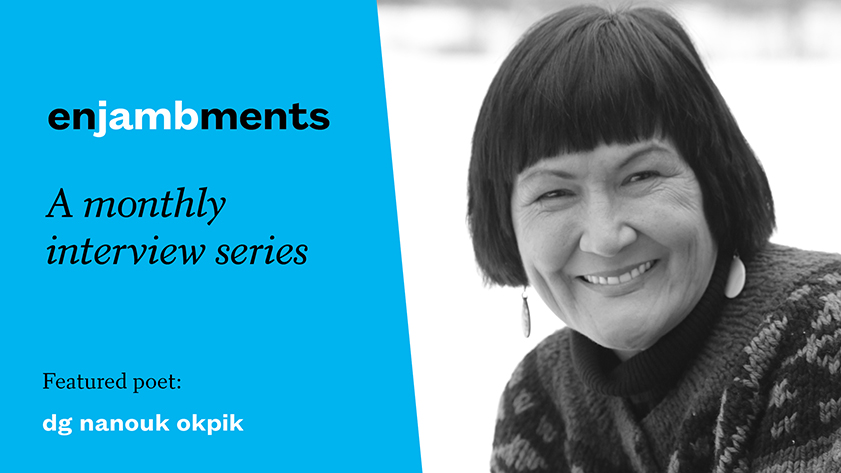
dg nanouk okpik is the author of Blood Snow (Wave Books, 2022) and Corpse Whale (University of Arizona Press, 2012), which won the American Book Award and the May Sarton Award. She lives in Santa Fe.
Poets.org: Juxtaposition is an important device in this book, and we see it appear both literally (“she/I,” “absence/presence”) and subtly within the collection’s themes and in poem titles such as “Forgrass,” “Spring Thaw,” and “Petrified Melt.” Through juxtaposition, time is reinforced as part of the natural world. How do you view the relationship between poetic time and time as a force of nature, particularly in poems in which the speaker seems to shape-shift in relation to the environment?
dg nanouk okpik: Juxtaposition in the poetry helps me bring together two different things next to each other in [such] a way [that] the reader sees the comparison in the poem. It develops atmosphere and setting along with tone, [and the] mood and attitude the poem provokes. The reader must do the work in my poetry. It’s not easy. Shape-shifting profound ideas allows for the interpretation of timing as atmosphere.
Poets.org: The poem “Anthropocene Years” centers on the idea of place, but otherwise has no center. Indexically, it’s here and there, pointing everywhere and nowhere all at once. How does this dissolving, even kaleidoscopic, sense of place relate to the poem’s title, which situates the setting in the wake of human-driven climate change?
dno: Human-driven climate change and actual change are variables up in the air. Selfish ideas are responsible for climate ruin. Man has control of these changes occurring to the Earth and can slow them down. Finding ways of slowing down is key, then humans can find a clear path of evolution.
Poets.org: In March 2020, your poem “When White Hawks Come” was featured in Poem-a-Day. In your “About This Poem” statement, you said, “I stayed there in the blue night in ‘mirth,’ rapture, and in laughter.” Night and twilight are mentioned often throughout Blood Snow in several poems, including “Twilight Pain,” where the body “rises to alleviate the deep nightlong pain of restlessness.” What did nighttime bring to light while writing this collection? What did it help you unearth?
dno: Light is always in play in my writing. It is twilight or half-light [that] plays on the Arctic [and] this is how I want my poems read: in half-light; not in full light. The ideas then can play off each other and bring together an inkling of what is shown and not shown in the poem. Light is skewed as the natural light play[s] in real time [with] poem, nighttime. Night and dusk/dawn always play a role in the writing.
Poets.org: Do you identify as being part of the eco-poetics movement? If so, could you elaborate more on the intimacy you have created between speaker/human and environment/land in this collection (i.e., “Whiteout Polar Bears,” “Ice Age Two,” and “Fossil Fuel Embers”), alongside the effects of climate change?
dno: I don’t feel I am an Eco-poet because this name, this label on my work, places my poetry in a neat, little, compartmentalized category. I have not reached my potential of writing in the many forms as a poet. The myriad forms of writing offer the poet adventure in creating many beginnings and many endings in the craft.
Poets.org: What are you currently reading?
dno: I’m always reading The Princeton Encyclopedia of Poetry and Poetics, Arthur Sze’s The Glass Constellation, Jennifer Foerster, and Layli Long Soldier’s Whereas.
Poets.org: What are your favorite poems on Poets.org?
dno: I like [Pablo] Neruda, Joy Harjo, and Layli Long Soldier.
